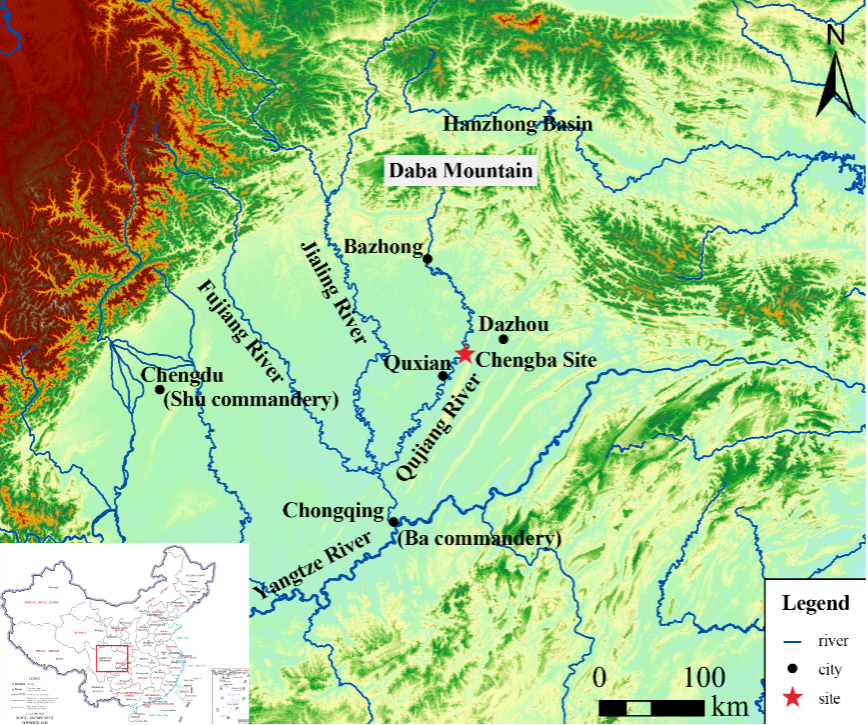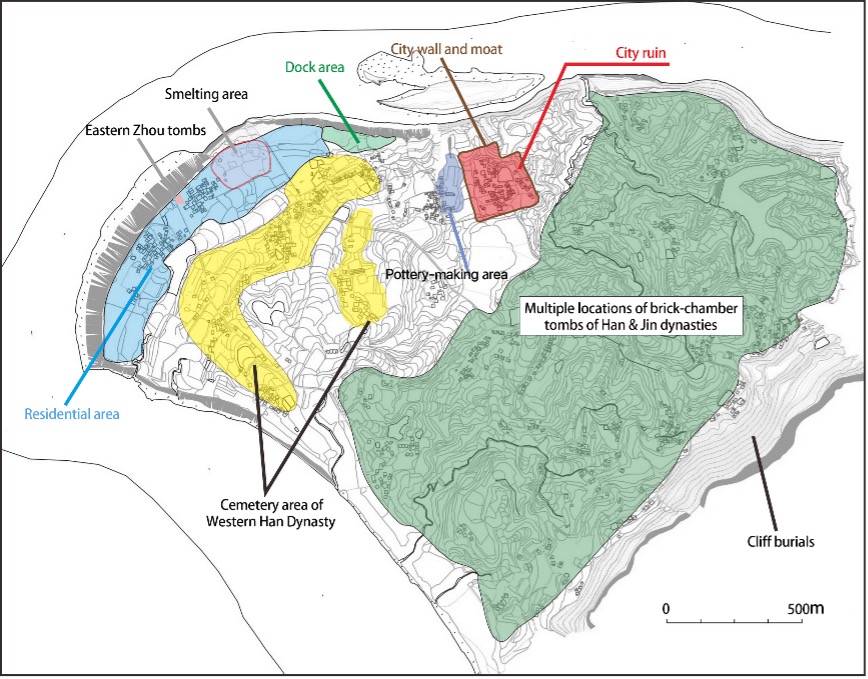Archaeol. Anthropol. Sci.|Archaeological Research on Iron Smelting Techniques at Chengba site in Eastern Sichuan Province
Recently, the Center for Archaeological Sciences and the School of Archaeology and Museology, Sichuan University, in collaboration with the Sichuan Provincial Institute of Cultural Relics and Archaeology, published their latest research findings titled “Iron Smelting Techniques in Eastern Sichuan Province, China——Scientific Analysis of Smelting Remains Excavated from the Chengba site” in the internationally authoritative archaeometric research journal *Archaeological and Anthropological Sciences*. Sun Tianqiang, a PhD candidate at the School of Archaeology and Museology, Sichuan University, is the first author of this paper. Associate Professor Li Yuniu from the Center for Archaeological Sciences and the School of Archaeology and Museology, Sichuan University, is the corresponding author. Researcher Chen Weidong from the Sichuan Provincial Institute of Cultural Relics and Archaeology, Professor Li Yingfu and PhD candidate Liu Fang from the School of Archaeology and Museology, Sichuan University, and Experimentalist Zhang Guiying from the Center for Archaeological Sciences, Sichuan University, are co-authors of this paper.
The Chengba site is located in Tuxi Town, Qu County, Dazhou City, Sichuan Province (Figure 1). This site is currently the earliest, longest-lasting, and largest ancient city site in eastern Sichuan. The site includes a city area, burial area, kiln area, Jinguan (customs/ferry station) area, and general settlement areas (Figure 2). It has also yielded many rare and important artifacts, such as Ba-style bronze objects from the Warring States period, ‘Dangqu’ eaves tiles from the Han and Jin dynasties, bamboo and wooden slips, and ironware. According to research, the city site within Chengba was likely the seat of ‘Dangqu County’ during the Han and Jin dynasties. The *Huayang Guozhi (Chronicles of Huayang)* records: “Dangqu County had an iron official during the Eastern Han Dynasty.” The *Hou Hanshu (Book of the Later Han)* records: “Dangqu County produces iron.” Since 2021, smelting remains have been unearthed in multiple areas within the site. Notably, in the general settlement area west of the city area, large accumulations of smelting waste have been discovered, mainly distributed in two long, narrow ash ditches. The excavated smelting waste includes slag, fragments of tuyeres, charcoal fragments, iron objects, and forging flakes. The typological characteristics of the excavated artifacts, combined with carbon-14 dating results, indicate that the smelting activities at the site date to the middle to late Eastern Han Dynasty. Statistically, more than 20,000 pieces of slag in various forms and over 1,200 fragments of furnace lining and tuyeres have been unearthed.

Figure 1 Geographical location of the Chengba site.

Figure 2 Functional zoning map of the Chengba site.
Research results based on the macroscopic morphology, microscopic metallographic structure, and chemical composition analysis of the smelting remains unearthed at the Chengba site indicate that the smelting remains from the site were likely produced during the bloomery iron smelting process and the forging of its products. The smelting remains can be categorized into high-silica refractory materials, high-silica high-iron bloomery slag, and high-iron slag-iron mixtures. The waste generated from bloomery iron production activities at the Chengba site mainly consists of refractory materials, accounting for over 50%; followed by slag-iron mixtures and tapped slag; with smaller quantities of iron blooms (or furnace bears) and furnace accretions. The smelting waste unearthed at the site is mainly concentrated in the two ash ditches. However, no ore or furnace wall fragments were found in these ditches, suggesting that waste materials such as refractory materials and slag generated during the smelting process were likely disposed of in dedicated dumping areas to separate the working environment from waste accumulation.

Figure 3 Typical smelting remains unearthed from the Chengba site.
Archaeological excavation results over the years indicate that iron tools began to appear at the Chengba site from the late Warring States period to the early Western Han Dynasty, by which time the site was under the rule of the Qin and Han dynasties. The interaction and integration of various cultural factors, including Central Plains culture, in the Ba-Shu region led to a surge in the variety and quantity of iron tools used in the area. The earliest iron tools at the Chengba site were likely products of external cultural exchange and integration. During the middle to late Western Han Dynasty, the use of iron tools at the site remained limited, becoming more widespread only in the Eastern Han Dynasty. The Han Dynasty iron artifacts unearthed at the Chengba site are primarily cast iron products, but no remains of cast iron smelting have been found at the site. These cast iron and steel products found at the site may have originated from other regions. The eastern Sichuan region, where the Chengba site is located, connects to the Hanzhong Basin to the north, and the Jialing River system within the region also provides convenient water transportation (Figure 1). This advantageous geographical location greatly facilitated resource exchange between eastern Sichuan and surrounding areas. The discovery of iron smelting remains at the Chengba site corroborates historical records, suggesting that the bloomery iron smelting activities at Chengba may have been part of the iron industry production overseen by the ‘Dangqu iron official’.
During the Qin and Han dynasties, with the formation and development of a centralized, multi-ethnic unified state, ancient Chinese ironware and the iron industry underwent comprehensive development, and ancient Chinese society fully entered the Iron Age. The Central Plains region was the first to complete the transition to an iron-based society (ironization), and numerous large-scale Han Dynasty iron production sites have been discovered in Henan, Shaanxi, Shandong, and other areas. The fully developed iron and steel technology in the Central Plains also drove the ironization process in remote regions. In recent years, several Han Dynasty iron smelting sites have been discovered in Southwest China, particularly the cluster of Han Dynasty cast iron smelting sites in the Chengdu Plain. The smelting technology at the Chengba site exhibits a technological system different from that of the Central Plains and the Chengdu Plain during the same period, indicating that at least during the Eastern Han Dynasty, some regions still maintained a technological tradition primarily based on bloomery iron production. This study fills a gap in the research on the development of Han Dynasty iron smelting technology in eastern Sichuan and also explains the factors influencing why the Han Dynasty iron smelting technology in eastern Sichuan differed from that of surrounding regions.
Zhang Bingyuan from the Sichuan Provincial Institute of Cultural Relics and Archaeology provided significant assistance with the archaeological research for this paper. Associate Researcher Tong Leixu from the Chengdu Municipal Institute of Cultural Relics and Archaeology provided significant assistance with the experimental analysis for this study.
This research was funded by the National Natural Science Foundation of China (Grant No. T2350410495), the Special Investigation Program for Scientific and Technological Basic Resources (Grant No. 2022FY101505), Sichuan University (Grants No. SKSYL2023-05, 2035xd-02), among others.
Author: Sun Tianqiang
Reviewed by: Li Yuniu
